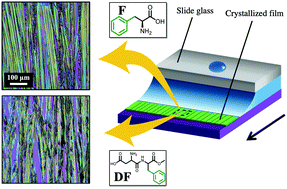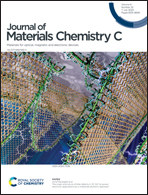Oriented crystal growth of phenylalanine and a dipeptide by solution shearing†
Abstract
Self-assembled structures of peptides have been recently gaining fundamental interest due to their unique electrical and optical properties arising from the variety of nanostructures. One of the challenges in this field is the formation of oriented nanostructures on a substrate. For more practical electrical applications, it is crucial to form their thin film on a substrate without losing their intrinsic physical properties due to random orientation. Here, we have developed a technique to form thin films of crystalized amino acids and dipeptides by solution shearing. We have characterized the thin films using polarized Raman spectroscopy and X-ray diffraction (XRD) measurements. Raman spectra revealed that the solution shearing allows us to form crystalline amino acids and dipeptides on Si wafers through control of crystal orientation along the direction of shearing. The XRD spectra supported the results of Raman spectroscopy, and also revealed the preferred orientation of the crystals in the out-of-plane direction. Futhermore, their polymorph formation was found to be suppressed by the solution shearing. This new approach to the formation of an aligned biomolecular thin film can be helpful for its bioelectronic applications in the future.



 Please wait while we load your content...
Please wait while we load your content...